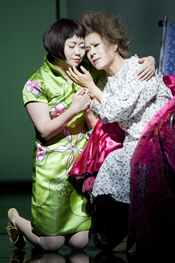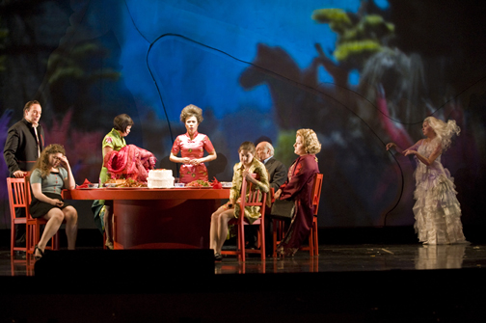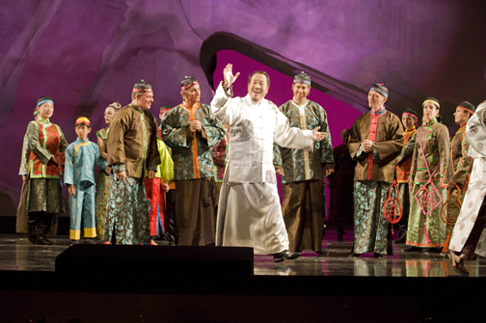![Zheng Cao (Ruth Young Kamen) [Photo by Terrence McCarthy]](http://www.operatoday.com/Ruth.png)
06 Oct 2008
On The Bonesetter’s Daughter
Decades ago a New Yorker cartoon showed a very little girl standing on tip-toe to return a book to a matronly librarian.
English Touring Opera are delighted to announce a season of lyric monodramas to tour nationally from October to December. The season features music for solo singer and piano by Argento, Britten, Tippett and Shostakovich with a bold and inventive approach to making opera during social distancing.
This tenth of ten Live from London concerts was in fact a recorded live performance from California. It was no less enjoyable for that, and it was also uplifting to learn that this wasn’t in fact the ‘last’ LfL event that we will be able to enjoy, courtesy of VOCES8 and their fellow vocal ensembles (more below …).
Ever since Wigmore Hall announced their superb series of autumn concerts, all streamed live and available free of charge, I’d been looking forward to this song recital by Ian Bostridge and Imogen Cooper.
Although Stile Antico’s programme article for their Live from London recital introduced their selection from the many treasures of the English Renaissance in the context of the theological debates and upheavals of the Tudor and Elizabethan years, their performance was more evocative of private chamber music than of public liturgy.
Evidently, face masks don’t stifle appreciative “Bravo!”s. And, reducing audience numbers doesn’t lower the volume of such acclamations. For, the audience at Wigmore Hall gave soprano Elizabeth Llewellyn and pianist Simon Lepper a greatly deserved warm reception and hearty response following this lunchtime recital of late-Romantic song.
For this week’s Live from London vocal recital we moved from the home of VOCES8, St Anne and St Agnes in the City of London, to Kings Place, where The Sixteen - who have been associate artists at the venue for some time - presented a programme of music and words bound together by the theme of ‘reflection’.
'Such is your divine Disposation that both you excellently understand, and royally entertaine the Exercise of Musicke.’
‘And there was war in heaven: Michael and his angels fought against the dragon; and the dragon fought and his angels, And prevailed not; neither was their place found any more in heaven … that old serpent … Satan, which deceiveth the whole world: he was cast out into the earth, and his angels were cast out with him.’
There was never any doubt that the fifth of the twelve Met Stars Live in Concert broadcasts was going to be a palpably intense and vivid event, as well as a musically stunning and theatrically enervating experience.
‘Love’ was the theme for this Live from London performance by Apollo5. Given the complexity and diversity of that human emotion, and Apollo5’s reputation for versatility and diverse repertoire, ranging from Renaissance choral music to jazz, from contemporary classical works to popular song, it was no surprise that their programme spanned 500 years and several musical styles.
The Academy of St Martin in the Fields have titled their autumn series of eight concerts - which are taking place at 5pm and 7.30pm on two Saturdays each month at their home venue in Trafalgar Square, and being filmed for streaming the following Thursday - ‘re:connect’.
The London Symphony Orchestra opened their Autumn 2020 season with a homage to Oliver Knussen, who died at the age of 66 in July 2018. The programme traced a national musical lineage through the twentieth century, from Britten to Knussen, on to Mark-Anthony Turnage, and entwining the LSO and Rattle too.
With the Live from London digital vocal festival entering the second half of the series, the festival’s host, VOCES8, returned to their home at St Annes and St Agnes in the City of London to present a sequence of ‘Choral Dances’ - vocal music inspired by dance, embracing diverse genres from the Renaissance madrigal to swing jazz.
Just a few unison string wriggles from the opening of Mozart’s overture to Le nozze di Figaro are enough to make any opera-lover perch on the edge of their seat, in excited anticipation of the drama in music to come, so there could be no other curtain-raiser for this Gala Concert at the Royal Opera House, the latest instalment from ‘their House’ to ‘our houses’.
"Before the ending of the day, creator of all things, we pray that, with your accustomed mercy, you may watch over us."
The doors at The Metropolitan Opera will not open to live audiences until 2021 at the earliest, and the likelihood of normal operatic life resuming in cities around the world looks but a distant dream at present. But, while we may not be invited from our homes into the opera house for some time yet, with its free daily screenings of past productions and its pay-per-view Met Stars Live in Concert series, the Met continues to bring opera into our homes.
Music-making at this year’s Grange Festival Opera may have fallen silent in June and July, but the country house and extensive grounds of The Grange provided an ideal setting for a weekend of twelve specially conceived ‘promenade’ performances encompassing music and dance.
There’s a “slide of harmony” and “all the bones leave your body at that moment and you collapse to the floor, it’s so extraordinary.”
“Music for a while, shall all your cares beguile.”
The hum of bees rising from myriad scented blooms; gentle strains of birdsong; the cheerful chatter of picnickers beside a still lake; decorous thwacks of leather on willow; song and music floating through the warm evening air.
![Zheng Cao (Ruth Young Kamen) [Photo by Terrence McCarthy]](http://www.operatoday.com/Ruth.png)
Decades ago a New Yorker cartoon showed a very little girl standing on tip-toe to return a book to a matronly librarian.
“The trouble with this book,” said the little girl, “is that it told me more about penguins than I really wanted to know.” The cartoon comes to mind as I assemble thoughts on The Bonesetter’s Daughter, the opera by Stewart Wallace and Amy Tan that premiered at the San Francisco Opera in September.
I jest, of course, for I am grateful for the immense amount of information at my disposal about the new work that I saw at its third performance in the War Memorial Opera House on September 25. My “homework” began with Tan’s bestselling 2004 novel, from which the author extracted the libretto for Bonesetter’s Daughter. It’s a large book — and a good one, and I wish that everyone would read it before seeing the opera. This is not to say that the opera is a series of sins of omission, for Tan has ably done what must always be done in reducing a big book to a libretto. She has worked with Wallace to create a work that, while new, is faithful to the novel.
She has, above all, preserved the truth of the book, the truth that unites three generations of Chinese women so seamlessly that they function at times as a single individual.
These are the things
These are the things I know
These are the things I know are true.
With those lines daughter Ruth, ageing mother LuLing and Precious Auntie, a ghost from an earlier China, open the score. They return in the course of the work.
 Zheng Cao (Ruth Young Kamen) & Ning Liang (LuLing Liu Young)
Zheng Cao (Ruth Young Kamen) & Ning Liang (LuLing Liu Young)
Reducing a novel to a libretto is an act of creative transformation, and the challenge differs with each work. I think, for example, of Ricky Ian Gordon’s Grapes of Wrath, premiered two seasons ago by Minnesota Opera. The Steinbeck classic, I thought, would defy such transformation. Wendell Korie, however, caught the epic sweep of the novel in his libretto. Korie, Wallace’s librettist for Harvey Milk, offered extensive advice to the creative team of Bonesetter’s Daughter.
Rather than generalizing about the process of transformation, a comparison of the task at hand says more about both operas. Korie had an easier job, for Grapes has essentially a group hero — the Joads — and Steinbeck follows them for a relatively brief time on their journey from Dust-Bowl Oklahoma to the — they hoped — greener pastures of California. The narrative line is simpler — and straighter.
 James Maddalena (Art Kamen), Rose Frazier (Fia Kamen), Zheng Cao (Ruth Young Kamen), Ning Liang (LuLing Liu Young), Madelaine Matej (Dory Kamen), Valery Portnov (Marty Kamen), Catherine Cook (Arlene Kamen), Qian Yi (Precious Auntie)
James Maddalena (Art Kamen), Rose Frazier (Fia Kamen), Zheng Cao (Ruth Young Kamen), Ning Liang (LuLing Liu Young), Madelaine Matej (Dory Kamen), Valery Portnov (Marty Kamen), Catherine Cook (Arlene Kamen), Qian Yi (Precious Auntie)
Tan’s story extends over the better part of a century and moves from America to China, whence this family came in the years after World War Two. Much disappears from Tan’s novel on the way to the opera stage. Only those who know something of the horrors of Mao’s Cultural Revolution will respond to mention of that age of repression in the libretto. And what American knows enough about calligraphy to appreciate what was involved in making ink for this ancient craft? This was the business of Precious Auntie’s family in China.
But back to reading. I am grateful that Ken Smith has documented the genesis of the new opera in Fate! Luck! Chance! Amy Tan, Stewart Wallace, and the Making of ‘The Bonesetter’s Daughter’ Opera (San Francisco, 2008. $24.95). Smith, long a respected music critic, has, with wife Joanna Lee, become the major mediator between American and Chinese music in this age of cultural cross-pollination. His book — rich in photos — records a creative process largely unique to opera, for Bonesetter’s Daughter is the product of a collective headed by Tan and Wallace that included director/choreographer Chen Shi-Zheng and the several musicians whom the two came to know on their several trips to China. Indeed, as I read about the many influences upon the work during the three years of its genesis I began to fear a collage of cultural fragments lacking specific identity. Happily, Bonesetter’s Daughter is anything but, and that is due largely to Wallace’s ability to assimilate what he experienced and express it in a voice that is totally his own.
 Hao Jiang Tian (Chang the Coffinmaker)
Hao Jiang Tian (Chang the Coffinmaker)
A Chinese-American opera; an American-Chinese opera? Just what is the work? It is decidedly American, and in Smith’s book Wallace defines his idiom in recalling his effort “to write music in my own language that felt Chinese without sounding ersatz Chinese.” He explains further: “You can hear this in the timbre and texture, but also in terms of the space between the notes that lets the music resonate with a sense of ritual.” That says it all and accounts for the newness — for the freshness and transparency of the score.
At 2 hours and 40 minutes, Bonesetter’s Daughter is nonetheless an engagingly intimate work exuberant in emotion. I felt at the end that it is a good work, not great perhaps, but good in its human authenticity.
Fate! Luck! Chance!, a documentary on the making of the opera, will be shown on public television in early 2009. Smith’s book includes the complete libretto of Bonesetter’s Daughter.
Wes Blomster